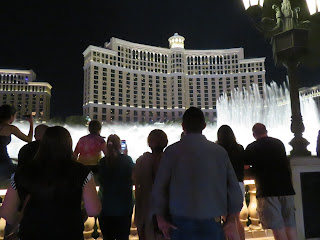“If you want to lift yourself up, lift up someone else.”
~Booker T. Washington
~Booker T. Washington
When I exited the Bellagio into the hot darkness of a Vegas August night, I knew exactly where I wanted to go. I had only one day in Vegas, and so I had spent the afternoon at Circus Circus, dinner at a buffet, and the evening at Cirque du Soleil’s “O”. The day wasn't done yet though—a fountain show was about to begin.
I'm not the only one who thinks the Bellagio fountains are one of the best things in town. By the time I arrived at the water's edge, crowds had already lined the lake. As the water began to dance with the music, there was not a spot to be had with an unobstructed view, not even a decent partial view.
Then I noticed, just back of the crowds, a fence protecting a tree trunk. Experience has taught me that barriers are often the best props and playgrounds, so it didn't take me long to see this fence's potential.
Even better, everyone was in front of the view-obstructing tree trunk, intently watching the water, so I wouldn't block anyone's view if I improved my own. Sold.
Up I went.
With my feet on a railing, my shoulder firmly against the solid trunk, I happily enjoyed my improved view as streams of liquid light surged to the music.
A minute or two into the show, the crowds were even denser, filling in more and more the space in front of my tree. As I glanced down at late arrivals searching for space, I noticed a braided head bobbing up and down—a little girl's frustrated attempts to see beyond the wall of bodies, heads, and mobile screens. I could sympathize with someone far shorter than me desperately wanting to see the fountains. I crouched down carefully on my perch and tapped her shoulder, catching the mother's attention as well. “Up here,” I said as I patted the railing by way of explanation and invitation. The girl gave me her hand, and in a moment was up in front of me. I moved farther around the back of the tree to make room for a younger sister to be boosted up as well. On my other side, an older brother (proudly) scrambled up on his own.
I had been happy with my vantage point, even a little pleased with the slight ingenuity and agility required to obtain it. As the show continued, I was even more glad about the little crowd that circled the tree in front of me. Six more feet had found sure footing above the ground, while three heads rose above the crowds to see something beautiful.
The music crescendoed then faded, jets of water sank down to mere eddies under the smooth surface of the water. The parents lifted down their children, ready to move on down to the next attraction on the Strip. Then, to my surprise, a hand reached up to help me down last of all—a father's simple thanks to a stranger.
With a few friendly words, we went our separate ways, but a tree, a fence, and a momentary friendship were for me souvenir memories as much as the bright city lights and fountain show.
I'm not the only one who thinks the Bellagio fountains are one of the best things in town. By the time I arrived at the water's edge, crowds had already lined the lake. As the water began to dance with the music, there was not a spot to be had with an unobstructed view, not even a decent partial view.
Then I noticed, just back of the crowds, a fence protecting a tree trunk. Experience has taught me that barriers are often the best props and playgrounds, so it didn't take me long to see this fence's potential.
Even better, everyone was in front of the view-obstructing tree trunk, intently watching the water, so I wouldn't block anyone's view if I improved my own. Sold.
Up I went.
With my feet on a railing, my shoulder firmly against the solid trunk, I happily enjoyed my improved view as streams of liquid light surged to the music.
A minute or two into the show, the crowds were even denser, filling in more and more the space in front of my tree. As I glanced down at late arrivals searching for space, I noticed a braided head bobbing up and down—a little girl's frustrated attempts to see beyond the wall of bodies, heads, and mobile screens. I could sympathize with someone far shorter than me desperately wanting to see the fountains. I crouched down carefully on my perch and tapped her shoulder, catching the mother's attention as well. “Up here,” I said as I patted the railing by way of explanation and invitation. The girl gave me her hand, and in a moment was up in front of me. I moved farther around the back of the tree to make room for a younger sister to be boosted up as well. On my other side, an older brother (proudly) scrambled up on his own.
I had been happy with my vantage point, even a little pleased with the slight ingenuity and agility required to obtain it. As the show continued, I was even more glad about the little crowd that circled the tree in front of me. Six more feet had found sure footing above the ground, while three heads rose above the crowds to see something beautiful.
The music crescendoed then faded, jets of water sank down to mere eddies under the smooth surface of the water. The parents lifted down their children, ready to move on down to the next attraction on the Strip. Then, to my surprise, a hand reached up to help me down last of all—a father's simple thanks to a stranger.
With a few friendly words, we went our separate ways, but a tree, a fence, and a momentary friendship were for me souvenir memories as much as the bright city lights and fountain show.










































